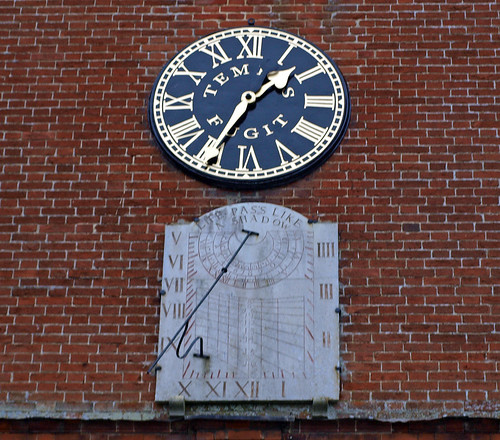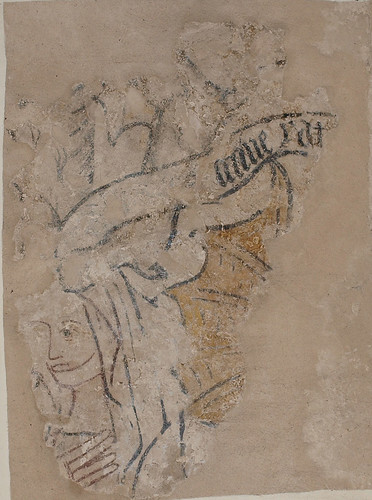That aside I found a whole new family connection to the Blois family buried here and an interesting building in a lovely village.
ST MARY. S porch tower of 1751-2. Red brick, with angle pilasters, short Doric below, very elongated Doric above. Arched windows; parapet. The chancel is of the late C13, as shown by the Piscina with dog-tooth decoration and the mouldings of the chancel arch. Dec S aisle, see the arcade (octagonal piers, double-chamfered arches) and the windows. Dec also the N doorway of the nave. The nave windows are Perp, and Perp too is the fine S chapel. Parapet with shields in the battlements and inscription referring to 1527 and Thomas Walle, salter of London, and his wife. Priest’s doorway set in the buttress, as at St Stephen Ipswich and at Trunch Norfolk. Perp clerestory of nine closely-set windows. A broad band of flushwork initials, etc., connects them. Perp finally the splendid nave roof, one of the most beautiful in Suffolk. It is a false double-hammerbeam roof, i.e. the upper hammers are false. Angels against the foot of the arched braces and against the harnmerbeams proper. The upper hammerbeams end against pendants coming down from the collars. Kingposts, again with small angel figures, on the collars. Short arched braces also connect the wall-posts in a W-E direction. Richly decorated wall-plate. Good roofs in the S aisle and S chapel too. In the S chapel the arched braces stand on angel corbels of stone. - FONT. On three steps, the upper two with quatrefoil friezes. Against the stem four lions. Against the bowl four lions and four angels, their heads just peeping out behind the shields they hold. - SCREEN. Good rood screen with one-light divisions. The dado of the S chapel screen has the Initials of Christ painted on as a repeat ornament. The upper parts simple. - BENCHES. A few with traceried ends, poppy-heads, and figures. - PAINTING. St Christopher; N wall. Further E on the N wall two C13 figures, discovered recently. - PLATE. Cup perhaps Elizabethan; Cup and Paten 1668; Almsdish 1676. - MONUMENT. Sir Charles Blois d. 1738. No effigy. Big inscription tablet with pilasters l. and r. with cherubs’ heads instead of, or in front of, the capitals. On top a trumpeting putto. The church lies in a good position N of the Green, but its situation is spoilt by the Victorian school immediately to its W and impaired by the War Memorial, which is a little too grand for the village and the place in front of the church.
GRUNDISBURGH. It is charming with thatched cottages and fine houses, among them Grundisburgh Hall, which dates from 1500 and hides in a wooded park. Near the church is a beautiful Tudor house with half-timbering and handsome brick chimneys,
Under little bridges on the green runs the River Finn, and looking on from the churchyard is a village cenotaph in memory of 30 men who died for the peace of the world. Seven men who went from here were awarded honours, two winning the DSO and one the Croix de Guerre.
A noble cedar shades the path to the church, which, though it has an 18th century brick tower, is mostly the work of 14th and 15th century builders. On the north side it is plain, but the south has much decoration. Between the clerestory windows there is ornamental flintwork, showing an almond tree in a pot, the words Ave Maria, and crowns. The nave and a Tudor chapel have panelled battlements, and in a delicate niche over the little doorway we see the Madonna carrying lilies. There is also a mass dial. The interior is light and spacious; and we are thankful that it is so, for here is magnificence which should not be hid. The screen in red and black and gold was fashioned 500 or 600 years ago, and is splendid with its fruit and foliage and traceried panels. In the chancel are two fine old beams, and in the 14th century aisle is a fine old roof with floral bosses and 14 wooden angels. But the greatest possession of Grundisburgh is the superb nave roof, a double hammerbeam structure 500 years old with a richly carved cornice, and no less than 58 angels arranged in three tiers.
There is a very attractive 13th century piscina, a modern pulpit carved in stone, corbel heads of angels and kings, an east window of the Ascension, and a handsome medieval font, with angels and crude lions on the bowl and more lions below. The octagonal piers of the nave are 600 years old, and still here are the stairs to the roodloft and a few fragments of ancient glass. There are old and new benches with poppyheads, four very handsome ones in the chancel being carved with the symbols of the Evangelists - a lion, a bull, an eagle, and an angel, all with wings.
A wall-monument of 1657 shows Robert Brook and his wife kneeling at a little desk, with a quaint group of seven children below; and a big stone crowned with a cherub blowing a golden trumpet tells of Charles Blois who died 200 years ago.
Under little bridges on the green runs the River Finn, and looking on from the churchyard is a village cenotaph in memory of 30 men who died for the peace of the world. Seven men who went from here were awarded honours, two winning the DSO and one the Croix de Guerre.
A noble cedar shades the path to the church, which, though it has an 18th century brick tower, is mostly the work of 14th and 15th century builders. On the north side it is plain, but the south has much decoration. Between the clerestory windows there is ornamental flintwork, showing an almond tree in a pot, the words Ave Maria, and crowns. The nave and a Tudor chapel have panelled battlements, and in a delicate niche over the little doorway we see the Madonna carrying lilies. There is also a mass dial. The interior is light and spacious; and we are thankful that it is so, for here is magnificence which should not be hid. The screen in red and black and gold was fashioned 500 or 600 years ago, and is splendid with its fruit and foliage and traceried panels. In the chancel are two fine old beams, and in the 14th century aisle is a fine old roof with floral bosses and 14 wooden angels. But the greatest possession of Grundisburgh is the superb nave roof, a double hammerbeam structure 500 years old with a richly carved cornice, and no less than 58 angels arranged in three tiers.
There is a very attractive 13th century piscina, a modern pulpit carved in stone, corbel heads of angels and kings, an east window of the Ascension, and a handsome medieval font, with angels and crude lions on the bowl and more lions below. The octagonal piers of the nave are 600 years old, and still here are the stairs to the roodloft and a few fragments of ancient glass. There are old and new benches with poppyheads, four very handsome ones in the chancel being carved with the symbols of the Evangelists - a lion, a bull, an eagle, and an angel, all with wings.
A wall-monument of 1657 shows Robert Brook and his wife kneeling at a little desk, with a quaint group of seven children below; and a big stone crowned with a cherub blowing a golden trumpet tells of Charles Blois who died 200 years ago.



No comments:
Post a Comment